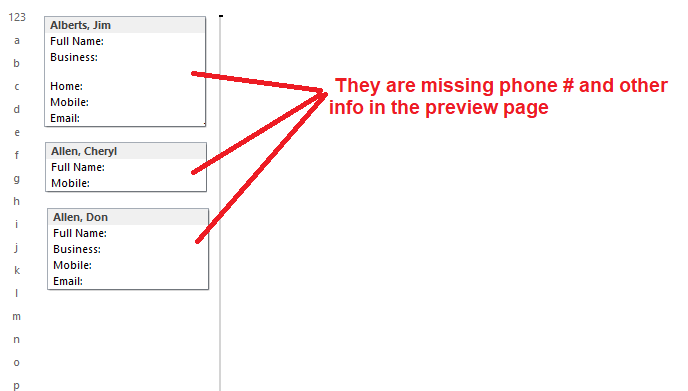- Business Card View In Outlook For Macbook
- Business Card View In Outlook For Mac Osx
- Outlook Contacts Business Card View
Import a vCard from an Outlook email message. To save vCards you receive as attachments as new contacts, add each vCard one-by-one to the list of Outlook contacts. In the body of the email message, click a vCard, right-click it, and then click Add to Outlook Contacts. A new window appears, displaying the contact information. If you would like to see other enhancements in Outlook for Mac, please vote for your feature request via Help Suggest a Feature. Known issues: Contact photo in the new card may differ from the photo in the message or event; The new card doesn't have alias or local phone number fields seen in the old card; The old card is showing for.
Original KB number: 3049193
Symptoms
In Microsoft Outlook 2010 and later versions, you discover that contact photos are missing from email messages and from contacts in the global address list (GAL). The following screenshots show an example of this issue in Outlook 2016.
You expect the contact photo to be displayed in Outlook, resembling the following.

You also discover that contact photos are missing in Skype for Business or Lync, as shown in the following screenshot.
Cause
Business Card View In Outlook For Macbook
This issue occurs when the Show user photographs when available check box is cleared in the Outlook Options dialog box.
Resolution Method 1 - Outlook Options
- On the File menu in Outlook, select Options, and then select People (or Contacts in Outlook 2010).
- Enable the Show user photographs when available check box.
- Select OK.
- Close and restart Outlook, and Skype for Business or Lync.
Resolution Method 2 - Group Policy
If you are using Group Policy to manage this setting, disable the Do not display photograph policy setting.
To update an existing policy that's configured to disable the Show user photographs when available option, follow these steps:
Start the Group Policy Management Console (GPMC).
Under User Configuration, expand Administrative Templates to locate the policy node for your template.
- When you are using the Office16.admx and Office16.adml templates, this node is named Microsoft Office 2016.
- When you are using the Office15.admx and Office15.adml templates, this node is named Microsoft Office 2013.
Under Contact Card, double-click Do not display photograph.
Select Disabled or Not Configured, and then select OK.
Select OK for the rest of the dialog boxes.
The policy setting will be applied on the client computers after the Group Policy update is replicated, and then Outlook and Skype for Business or Lync must be closed and restarted for the setting to take effect.
More information
Business Card View In Outlook For Mac Osx
The Do not display photograph setting is managed by the following registry data:
Without Group Policy:
Key:
HKEY_CURRENT_USERsoftwareMicrosoftOfficex.0common
DWORD: TurnOffPhotograph
Value: 1With Group Policy:
Key:
HKEY_CURRENT_USERsoftwarePoliciesMicrosoftOfficex.0common
DWORD: TurnOffPhotograph
Value: 1
Note
The x.0 placeholder represents your version of Office (16.0 = Office 2016, Office 365 and Office 2019, 15.0 = Office 2013, 14.0 = Office 2010).
TL;DR version – if you don’t see any groups in the Contact card for users in your tenant, and instead see the membership empty or a message such as “We couldn’t find any groups.”, this is a known issue and not something you’ve misconfigured.

Apparently this bug has been around for a while, but I only noticed it today. In a nutshell, if you happen to have more than one Exchange Online/Office 365 account added to Outlook in the same profile, some issues with displaying the Membership part of the Contact Card might be observed. In my particular scenario, this is what I see when hovering over any of the contacts in my personal tenant:
At the same time, if I look at the contact card in OWA, membership is reflected correctly. Similarly, if I look at the user details in the Address book, you will see the full list of Groups the user is a member of, and you might even see some of the Role groups.
What’s more interesting (or annoying) is that for my work profile, which also uses Office 365 and is added to the same Outlook profile, everything works as expected. I’ve tested the issue with different Outlook versions, one on the Monthly channel, another one on the Semi-Annual one (Targeted), with no difference in behavior. In addition, switching between Cached and Online mode doesn’t make a difference either.
Outlook Contacts Business Card View
The workaround provided by Microsoft is to use a single account in the profile, which is the only configuration that does seem to work OK in my tests. Then again, this issue is nowhere impactful enough to make me switch to using separate profiles for the multitude of accounts I have in Outlook. Hopefully Microsoft will sort it out in one of the coming builds.